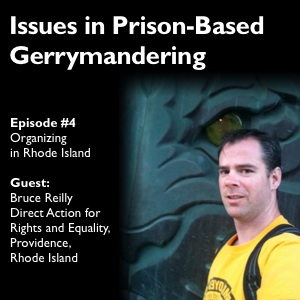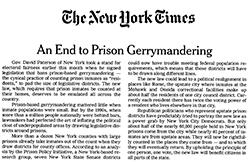Delaware Governor Jack Markell has signed HB384 in to law, ending prison-based gerrymandering in that state.
by Peter Wagner,
September 1, 2010
I just received this press release from the Delaware House Majority announcing the governor’s signature of the bill ending prison-based gerrymandering. You can also read the bill or the Prison Policy Initiative / Demos press release from the bill’s passage.
Delaware House of Representatives House Majority Caucus
 For Immediate Release:
For Immediate Release:
Contact: Drew Volturo
September 1, 2010
Work: (302) 744-4001
Cell: (302) 593-5969
BILL ENSURING ACCURATE REDISTRICTING
COUNT SIGNED INTO LAW
Inmates would be counted at permanent residence instead of at correctional facility
WILMINGTON – Legislation ensuring that the population of each Delaware municipality and legislative district is accurately counted was signed into law on Tuesday afternoon.
Sponsored by Rep. Helene M. Keeley, House Bill 384 requires that inmates in a Delaware prison at the time of the decennial U.S. Census will be counted in the area they resided immediately prior to incarceration instead of being counted at the address of the correctional facility. Under the measure, the state would not be able to count prisoners who did not live in Delaware before they were incarcerated as part of the population. This would apply in determining the reapportionment and redistricting for the state.
The current practice of including prison populations in the districts in which the facilities are located artificially pads those districts and leaves inmates’ home districts under-represented. This skews research and demographic data that local governments and various groups use for planning purposes and to allocate resources.
“Most people who are in prison are not there for long periods of time,” said Rep. Keeley, D-Wilmington South. “When they are released, they often return to the communities they lived in before they were in prison. Having an accurate district population count helps government and nonprofit agencies plan and offer services more effectively.”
Maryland’s legislature passed its “No Representation Without Population Act” in April, becoming the first state to enact such a measure. New York State also passed a similar measure this summer.
According to the Prison Policy Initiative, which advocates for passage of such laws, four states (Colorado, Mississippi, New Jersey and Virginia) encourage or even require local governments to exclude prison populations during redistricting. The group also lists Wilmington as an example of cities throughout the country that are affected by prison-based gerrymandering.
###
 The NAACP LDF will be holding the Voting Rights and Redistricting Training Institute at the Airlie Conference Center in Warrenton, VA on October 8 and 9.
The NAACP LDF will be holding the Voting Rights and Redistricting Training Institute at the Airlie Conference Center in Warrenton, VA on October 8 and 9. For Immediate Release:
For Immediate Release: Play (21:24, 11.3MB)
Play (21:24, 11.3MB) The New York Times cites our research on prison-based gerrymandering in the
The New York Times cites our research on prison-based gerrymandering in the 


